汽车专业英语
汽车专业英语
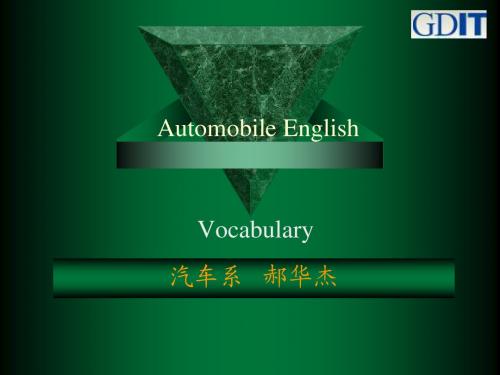
90. electrically erasable programmable read only memory 电可擦可编程只读 存储器 (EEPROM) 91.vehicle speed sensor车速传感器(VSS) 92. revolutions per minute转/分(RPM) 93. light emitting diode发光二级管(LED) 94. oil pickup tube 机油进油道 95. oil gallery 机油油道 96. hydraulic lifter 气门挺杆 97. valve train 气门组
46. overhead-cam engine (OHC) 顶置气门/上置凸轮轴发动机 47. gaseous ring 气环 48. oil ring 油环 49. diesel/gasoline/oil/air filter 柴油/汽油/机油/空气滤清器 50. muffler 消声器 51. thermostat 节温器 52. manual transmission 手动变速器(MT)
Automobile English
Vocabulary 汽车系 郝华杰
1. gasoline/diesel engine 汽油机/柴油机 2. chassis 底盘 3. body 车身 4. electrical equipment 电气设备 5. cylinder block 缸体 6. cylinder head 缸盖 7. crankshaft and connecting rod mechanism 曲柄连杆机构 8. admission gear 配气机构 9. the fuel supply system 燃油供给系 10.cooling system 冷却系
汽车专业英语
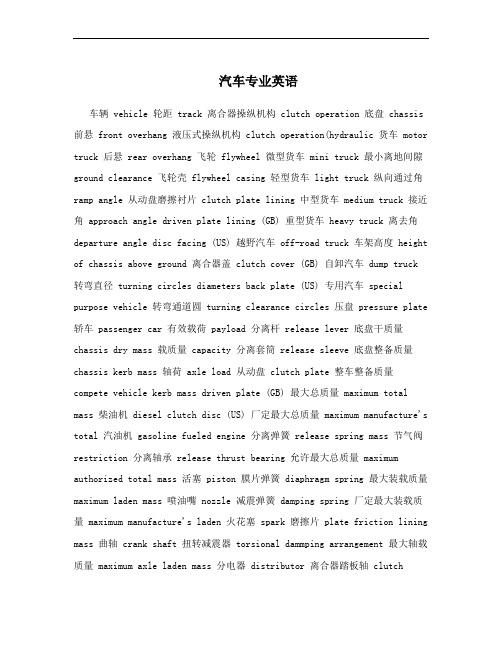
汽车专业英语车辆 vehicle 轮距 track 离合器操纵机构 clutch operation 底盘 chassis 前悬 front overhang 液压式操纵机构 clutch operation(hydraulic 货车 motor truck 后悬 rear overhang 飞轮 flywheel 微型货车 mini truck 最小离地间隙ground clearance 飞轮壳 flywheel casing 轻型货车 light truck 纵向通过角ramp angle 从动盘磨擦衬片 clutch plate lining 中型货车 medium truck 接近角 approach angle driven plate lining (GB) 重型货车 heavy truck 离去角departure angle disc facing (US) 越野汽车 off-road truck 车架高度 height of chassis above ground 离合器盖 clutch cover (GB) 自卸汽车 dump truck 转弯直径 turning circles diameters back plate (US) 专用汽车 special purpose vehicle 转弯通道圆 turning clearance circles 压盘 pressure plate 轿车 passenger car 有效载荷 payload 分离杆 release lever 底盘干质量chassis dry mass 载质量 capacity 分离套筒 release sleeve 底盘整备质量chassis kerb mass 轴荷 axle load 从动盘 clutch plate 整车整备质量compete vehicle kerb mass driven plate (GB) 最大总质量 maximum total mass 柴油机 diesel clutch disc (US) 厂定最大总质量 maximum manufacture's total 汽油机 gasoline fueled engine 分离弹簧 release spring mass 节气阀restriction 分离轴承 release thrust bearing 允许最大总质量 maximum authorized total mass 活塞 piston 膜片弹簧 diaphragm spring 最大装载质量maximum laden mass 喷油嘴 nozzle 减震弹簧 damping spring 厂定最大装载质量 maximum manufacture's laden 火花塞 spark 磨擦片 plate friction lining mass 曲轴 crank shaft 扭转减震器 torsional dammping arrangement 最大轴载质量 maximum axle laden mass 分电器 distributor 离合器踏板轴 clutchpedal shaft 允许最大轴载质量 maximum authorized axle laden 进气口 inlet 离合器踏板臂 clutch pedal lever mass 排气口 outlet 离合器踏板 clutch pedal pad 比功率 power/mass ratio 发电机 alternator 分离推杆 release rod (operating rod) 比扭矩 torque/maximum total mass ratio 飞轮壳 flywheel housing 分离推杆叉 push-rod fork 车长 vehicle length 分离套筒总成 sleeve assembly 汽车长 motor vehicle length 离合器 clutch 分离叉 withdrawalfork (operating 车宽 vehicle width 摩擦式离合器 friction clutch fork) 车高 vehicle height 膜片弹簧离合器 diaphragm spring clutch 分离叉球头支座 operating fork ball-end 轴距 wheel space 单盘离合器 single plate clutch 分离叉回位弹簧 operating fork return spring- 1 -离合器操纵机构主缸 clutch release master cylinder 油箱容积 tank capacity 驾驶室覆盖件 cover panel 储液罐 fluid reservoir 滤清器 filter 内饰件 interior trimming parts 联接软管 hose (flexible hydraulic pipe) 汽油滤清器 gasoline filter 外饰件 exterrior trimming parts 变速器油箱盖fuel tank cap 附件 equipment 滑动齿轮变速器 sliding gear transmission 滤网. 粗滤器 strainer 挡板 guard常啮合式变速器 constant mesh transmission 后桥板件 panel全同步器式变速器 all synchromesh transmmission 非独立悬架式驱动桥rigid drive axle 衬板 patch直接档变速器 direct drive ransmission 独立悬架式驱动桥 independent suppension drive 连接板 connecting panel 超速档变速器 over drive transmission axle 盖 lid手动换档变速器 manually shifted transmission 单级主减速器 single reduction finaldrive 罩 cover 直接操纵变速器 direct control transmission 轮边减速器 wheel reductor or hud reductor 支架 support(bracket . brace) 远距离操纵变速器 remote control transmission 差速器 differential 骨架member(rail beam) 传动轴桥壳 axle housing 筋 rib万向节 universal joint 半轴 axle shaft 密封条 weatherstrip 非等速万向节 nonconstant velocity universal joint 全浮式半轴 full-floating axle shaft 衬垫 pad(packing .gasket) 等速万向节 constant velocity universal joint 半浮式半轴 semi-floating axle shaft 装饰件 trimming(finisher. molding) 万向节夹角 true joint angle 驱动桥最大输入扭矩 drive axle maximum input 驾驶室悬置 cab mounting 十字轴式万向节 cardan or hookes universal joint torgue 地板 floor pan(floor panel) 万向节叉 yoke 驱动桥额定桥荷能力 rating axle capacity 纵梁 side rail(side member) 突缘叉flange yoke 驱动桥额定输入扭矩 drive axle allowable input 横梁 crossrail 滑动叉 slip yoke torgue 轮罩 wheel housing 滑动轴 slip shaft 驱动桥额定输出扭矩 drive axle allowable output 挡泥板 mudguard 花键轴叉 slip shaft yoke torgue 发动机罩 engine cover 十字轴 cross 驱动桥减速比 drive axle ratio 风窗玻璃 windshield glass 十字轴总成 cross assembly 驾驶室侧窗玻璃 side window glsaa 传动轴 drive shaft 平头驾驶室 forward control cab 门窗玻璃 door window glass 允许滑动量 slip 长头驾驶室 conventional cab 后窗玻璃 rear window glass 相位角 phase angle 双排座驾驶室 crew cab 仪表板 instrument panel(facia) 中间支承 shaft support 带卧铺驾驶室sleeper cab 杂物箱 glove box供油系装置翻转式驾驶室 tilt cab 翻转机构 tilting mechanical hardware 油箱 tank 驾驶室本体 main body 门铰链 hinge- 2 -玻璃升降器 window regulator 缓冲垫 cushion rubber (bumper) 排气系后视镜 rear view mirror 反光器 reflector 排气消声器 silencer 刮水器wiper 车轮夹箍(夹子) clip 风窗洗涤器 washer 车轮 wheel 凸缘 flange 遮阳板 sun visor 轮胎 tyre 排气管 outtake 空调装置 air conditioner(air conditioning 外胎 cover 悬架系统equipment) 内胎 inner tube 非独立悬架 rigid axle suspension 暖风装置heater 独立悬架 independent suspension 冷风装置 cooler 层级 mumber of rating 纵置板簧式 parallel leaf spring type 通风装置 ventilator 轮胎换位tyre rotation 双横臂式 double wish-bone arm type 除霜装置defrostor(demister) 轮辋 rim 双纵臂式 double trailing arm type 肘靠 arm rest 斜交轮胎 diagonal tyre 单横臂式 single swing arm type 扶手hahdrail(hand grill. banisters) 带束斜交轮胎 bias belted tyre 单纵臂式single trailing arm type 拉手 assist grip(handle) 子午线轮胎 radial ply tyre 变截面弹簧 tapered spring钢板弹簧 leaf spring laminated spring 安全带 seat belt 胎冠 crown 标牌 label 胎面 tread 螺旋弹簧 coil spring helical spring 汽车商标emblem(mark. insignia) 胎侧 sidewall 扭杆弹簧 torsion bar spring 货厢缓冲层 breaker 空气弹簧 air spring 货箱 cargo body(conventional type rear body. 带束层 belt 橡胶弹簧 rubber spring high deck body) 轮胎气门嘴 tyre valve 油气弹簧 hydro-pneumatic spring 厢式货箱 van body 标准轮辋 standard rim 液体弹簧 hydraulic spring 低台货箱 low deck body 允许轮辋 permitted rim 减振器 shock absorber 高栏板货箱 high gate cargo body 断面宽度 section width 筒式减振器 telescopic shock absorber 梁 sill 外直径 overall diameter 横向稳定器 stabilizer anti-roll bar 纵梁 mainsill(main bolster.side sill) 自由半径 free radius 吊耳 shackle 纵梁垫木wood filler block(main sill liner) 静负荷半径 static loaded radius 钢板弹簧衬套 leaf spring bushing 横梁 cross sill (bolster) 动负荷半径dynamic loaded radius 钢板弹簧销 leaf spring pin 货箱栏板 gate 滚动半径rolling radius U型螺栓 U bolt 边板 side gate 双胎最小间距 minimum dual spacing 橡胶衬套 rubber bushing 栏板铰链 gate hinge 单胎负荷 single load 缓冲块 buffer stopper 栏板立柱 support post 双胎贡荷 doal load 限位块limiting stopper- 3 -行车制动回位弹簧 return spring 转向螺杆 steering screw 制动系braking system 推杆 plunger 指销 stud(peg)制动主缸 brake master cylinder 行车制动系 service braking system 齿轮齿条式转向器 rack and pinion steering gear 驻车制动系 parking braking system 串列双腔式制动主缸 series dual-chamber brake 动力转向器 power steering gear 气压制动系 air braking system master cylinder 转向传动机构steering linkage 液压制动系 hydraulic braking system 真空助力器 vacuum booster 转向摇臂 pitman arm 单回路制动系 single-circuit braking system 真空增压器 vacummintensifier 转向直拉杆 steering drag link 双回路制动系dual-circuit raking system 制动鼓 brake drum 球头销 ball stud 制动器brake 制动底板 brake bottom plate 球头座 ball cup 摩擦式制动器 friction brake 制动衬片 friction lining (摩擦片) 压缩弹簧 compressing spring 鼓式制动器 drum brake 制动蹄 brake shoe 直拉杆 drag link 盘式制动器 dics brake 安全缸 safety cylinder 转向节臂 steering (knuckle) arm 双领蹄式制动器 two leading shoe brake 转向系统梯形机构 tie rod linkage 双从蹄式制动器 two trailing shoe brke 机械转向系 manual steering system 横拉杆 tie rod动力转向系 power steering system 双向双领蹄式制动器 duo two leading shoe brake 摆臂 swing arm 双向双从蹄式制动器 duo two trailing shoe brake 转向操纵机构 steering control mechanism 转向系角传动比 steering system angle ratio 领从蹄式制动器 leading trailing shoe brake 转向万向节steering universal joint 转向器角传动比 steering gear angle ratio 制动管路 braking line 转向传动轴 steering inner articulated 转向传动机构传动比steering linkage angle ratio 报警装置 alarm device 转向管柱 steering column 转向器传动效率 steering gear efficiency 报警压力 alarm pressure 转向轴 steering shaft 正效率 forward efficiency 真空泵 vacuum pump 转向盘 steering wheel 逆效率 reverse efficiency 真空筒 vacuum tank 蜗杆滚轮式转向器 worm and roller steering gear 转向系刚度 steering system stiffness 空压机 air compressor 循环球式转向器 recirculating ball steering gear 转向盘总圈数 total turns of steering gear 储气筒 air storange reservoir 转向器盖 cover of steering gear 转向盘自由行程 free play of steering wheel 调压阀 pressure regulating valve 壳体 housing 转向器传动间隙 steering gear clearance 单向阀 single check valve 转向蜗杆steering worm 摇臂轴最大转角 max. swing angle of steering 排放阀 drain valve 滚轮 roller pitman arm制动踏板 braking pedal 滚轮轴 roller shaft 转向力矩 steering moment 踏板护套 pedal pad 侧盖 side cover 转向器最大输出扭矩 steering gear max.output torque 踏板支架 pedal bracket 摇臂轴 pitman arm shaft 最大工作压力 max. working pressure 销轴 axis pin 转向螺母 steering nut 额定工作压力 rated working pressure- 4 -。
汽车专业英语
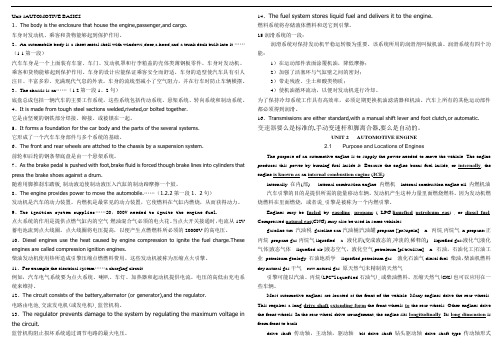
Unit 1AUTOMOTIVE BASICS1、The body is the enclosure that house the engine,passenger,and cargo.车身对发动机、乘客和货物能够起到保护作用。
2、An automobile body is a sheet metal shell with windows,door,a hood,and a trunk deck built into it.……(1.1第一段)汽车车身是一个上面装有车窗、车门、发动机罩和行李箱盖的壳体类薄钢板零件。
车身对发动机、乘客和货物能够起到保护作用。
车身的设计应能保证乘客安全而舒适。
车身的造型使汽车具有引人注目、丰富多彩、充满现代气息的外表。
车身的流线型减小了空气阻力,并在行车时防止车辆横摆。
3、The chassis is an……(1.2第一段1、2句)底盘总成包括一辆汽车的主要工作系统,这些系统包括传动系统、悬架系统、转向系统和制动系统。
4、It is made from tough steel sections welded,riveted,or bolted together.它是由坚硬的钢铁部分焊接、铆接、或被锁在一起。
5、It forms a foundation for the car body and the parts of the several systems.它形成了一个汽车车身部件与多个系统的基础。
6、The front and rear wheels are attched to the chassis by a suspension system.前轮和后轮的钢条帮底盘是由一个悬架系统。
7、As the brake pedal is pushed with foot,brake fluid is forced though brake lines into cylinders that press the brake shoes against a drum.随着用脚推刹车踏板,制动液迫使制动液压入汽缸的制动蹄摩擦一个鼓。
常用汽车专业英语

1 ACC activated carbon can ister 活性碳罐2 ACI automatic car ide ntificati on system 汽车自动识别系统3 air cushi on car 气垫车4 air-cooled car 空气冷却式汽车,空冷式车辆,空冷式轿车(装用空冷式发动机的轿车)5 APC aperture card 穿孔卡片6 ASU automatic in terfere nee suppressi on for car radios suppresses ign iti on no ise in the FM band 调频干扰自动抑制,在汽车收音机中附加入此电路即可抑制高压点火(噪音)的干扰7 baby car 微型轿车,超微型轿车(美俚语,=mini car,cycle car,midget car); 婴儿小车8 backfiring in carburetor 化油器回火(二explosion in the carburetor)9 baggage car 行李车10 brake shoe carrier 制动蹄座11 brush carrier 刷架12 C&M care and mai nte nance 维修及保养13 C.CARB con ve ntio nal carburetor 常规化油器14 C.P. car park (停)车场15 C/O carry over 携带16 cable-test ing car 电缆检查车17 car aerial 汽车天线(二automobile aerial)18 Car Alarm theft-deterre nt system 汽车防窃警报系统19 car antenna 车上天线,车载天线,汽车天线20 car body 轿车车身21 car mechanic 汽车维修工,机动车维修工22 car navigation computer 车用导航计算机,车用导行计算机23 car park 停车场,停车处24 car wait ing to repair 待修汽车25 car wan der 汽车蛇行26 car wash洗车台,汽车清洗站27 car wash trade 洗车业28 car washer洗车设备,洗车机;街道清洗机29 car wash ing departme nt30 car washing installation31 car washing installation洗车工间,车辆清洗工间洗衣装置,洗车设备洗衣装置,洗车设备32 car wash ing machi ne 洗车机33 car with elevator 带升降机车辆,升降机汽车34 car with four in depe nde nt wheels 四轮独立悬架式轿车35 carb化油器汽化器(carburator 的简称)36 CARB 1.化油器(carburettor) 2. 碳化,渗碳(carbonization)37 carb adjustment 化油器调准,化油器调节38 CARB California Air Resources Board 加里福尼亚大气资源局39 CARB carburetor 化油器,汽化器40 carboard 纸板,硬纸板41 carbon碳(代号C);碳棒,电刷,石墨,积炭,积碳层42 carbon electrode 碳棒,碳电极43 carbon monoxide —氧化碳(CO)44 carbo ni zation test (润滑油)积炭试验45 CARE corporate average regulated emissio n 公司规定的平均有害物排放量46 CARP cooperate automotive research program 汽车合作研究程序47 CARR carriage 车溜板48 CARR carrier 运载工具,载体49 carriage车辆,车架,支架,托架;(机床的)拖板;机器的滑动部分;底座,底盘;承重装置,承载器; 运输,运费50 carriage body 车身51 CARS computer aided routing system 计算机辅助(运输网络中)选线系统52 CART carto n 卡片纸53 cartridge 管壳,盒卡盘,夹头座;套筒;衬套(过滤器的)芯子;(照像)胶卷;支架54 cartridge fuse 熔断丝管,熔断丝55 cartridge paper 画图纸,图画纸56 CAT carburetor air temperature 化油器空气温度57 CFC chlorofluorocarbo ns 含氯氟烃(氟属致冷剂)58 CFRC carb on fiber frictio n material 59 CFRP carb on fiber rein forced plastic 60 CL car load 车辆载负61 CLCC closed loop carburetor control 62 CO carbon mo noxide —氧化碳 63 CO2 carbon dioxide 二氧化碳 64 COEI carb on-mono xide emissi on in dex65 COF container-on-flt car平板车装运集装法,集装箱在平板货车上的运输方法66 con vertible car 活顶篷轿车67 COTY car of year 当年(流行)的汽车,年款汽车 68 CP car post 停车场 69 CPT carpet 地毯 70 CR carriage return 回车71 CUCV commercial utility cargo vehicle商用,轻型,多用途载货汽车72 DCCSC divided-chamber carbureted stratified-charge engine 分隔式燃烧室混合气层状充气发动机73 diaphragm carburettor膜片式化油器74 diesel-engined passenger car柴油(发动)机客车,柴油机轿车75 differential carrier 差速器壳(=differential case,differential housing ) 76 dismantling from car to units 汽车拆成部件,汽车拆成总成77 drill carriage 钻轴滑座78 ECC electro nically con trolled carburetor电子控制的化油器79 ECC-CU (con trol unit ) electro nically con trolled carburetor control unit 电子控制的化油器控制装置80 EFC electronic fecdback carburetor 电子反馈式控制化油器(电脑根据排气管中 O2传感器信号,自动调节空燃比)81 EFC electro nic fuel con trolled carburetor 电子燃油控制化油器82 EIC carbon emissio n in dex 碳排放量指数 83 electro ni cally con trolled carburetor电脑控制化油器,电子控制式化油器(简称ECC )84 electro nically con trolled carburetor-c on trol unit 电子控制式化油器的电子控制器 (简称 ECC-Control unit ) 85 emissi ons carburetor防污染化油器碳纤维摩擦材料 碳纤维强化塑料闭环化油器控制氧化碳排放指数86 enclosed cardan shaft 圭寸闭式传动轴(=encased propeller shaft)87 EOHC engin e-out hydrocarbo n 发动机排出的碳氢化合物88 explosion in carburetor 化油器回火(放炮)89 explosio n in the carburettor 化油器回火(=backfiri ng in carburetor,blowback,popp ing back)90 exposed cardan shaft 开式万向传动轴开式甲唐轴91 fast back car 斜背式轿车92 FBC feedback carburetor 反馈控制式化油器93 float carburettor 浮子式化油器94 float of carburettor 化油器,浮子95 forecarriage (挂车)前转向架96 four door con vertible car 四门车篷可折叠式轿车97 four-tire car 四轮胎轿车(指使用被尖物刺穿或放炮漏气后仍能继续行驶的轮胎,因而不再需要备用胎的的汽车)98 front-wheel-drive car 前轮驱动轿车(简称f-w-d car)99 fuel-cell car 燃料电池(驱动的)轿车(1996年5月14日,由Mercedes-Benz 公司在柏林展出世界上第一辆氢燃料电池轿车,系将甲醇在车上通过一个专门的反应器,产生H2和C02, 接着将H2导入一个聚合物电池,在触媒的作用下,与空气反应,产生H2O和电流,用电流驱动车辆)100 f-w-d car 前轮驱动轿车(front-wheel drive car)101 general purpose car 万能车,万用车,多用途车多功能轿车(如全轮驱动的北京切诺基轿车)102 GPC glass carbo nate composite 玻璃聚碳酸酯复合材料103 GT grade touri ng car 跑车104 GT grand touri ng car 豪华高速旅游车105 H/C fuel hydrogen/carbon ratio 燃油中(烃的)氢碳比106 H/C hydroge n/carbo n (烃的)氢碳比107 HC hydrocarbo n 碳氢化合物108 H-Carb Hitachi 2Bbl carburetor (日本Hitachi)两腔化油器109 HCEI hydrocarbon emissi on in dex 碳氢化合物排放指数110 HCS high carbon steel 高碳钢111 HCSHT high carbon steel heat treated 热处理过的高碳钢112 HPSiC hot-pressed silicon carbide 热压碳化硅113 IFC carb in tegrated fuel c on trol carburetor 综合控制供油化油器114 implement carrier 机具运载装置,通用机架115 in strume nt carrier panel 仪表板(=i nstrume nt board)116 in strume nt carrier plate 仪表板(二in strume nt board)117 in sulat ing carto n 绝缘纸板118 intelligent car 智能化汽车,无人驾驶汽车,智能轿车(指运用计算机技术、电子技术、信息技术,使汽车能以最佳路线,最佳工况行驶,且能在自动公路上无人驾驶,自动行驶)119 in tercar radio 汽车之间的无线电通讯装置,车间无线电通讯装置120 ISCO indicated specific carbon monoxide 指示马力一氧化碳排放率(量)121 ITC international touring car championship 国际旅游(游览)轿车冠军122 jet carburetor 喷雾式化油器123 KDC knock down car 就地装配的汽车,当地组装的汽车124 KDCL knock dow n in carloads (货物)以散装状态装车125 laggage carrier (车内)行李架,行李搬运车(=bag-gage carrier)126 lamp carrier 灯座127 LCL less-than-carload 零担的(货运)128 lining of car 车身衬里129 load-carrying 承载负荷的,承载的,承重的130 long base car 长轴距轿车131 luggage carrier 行李箱,行李架132 luggage carrier exte nsion (汽车)行李架的延长部分133 luggage carrying capacity 行包承载能力,行李容量(=luggage capacity)134 M.CARB modified carburetor 改进的化油器135 mai n carburettor 主化油器136 microprocessor controlled car 微机控制轿车(一般指微机控制点火、喷油、变速的轿车)137 motor car mechanic(ian)轿车技工,轿车技师,轿车机械技术员(二automobile mecha nic)138 motorcar headlamp 汽车前照灯(=automobile headlamp)139 motorcar horn 汽车喇叭,轿车用喇叭140 motorcar owner 轿车车主141 motorcar radio set 汽车收音机(亦称motorcar set)142 motorcar repair shop 汽车修理场,轿车修理车间,轿车检修站143 motorcar rim 小汽车轮辋,轿车轮辋144 motorcar set 轿车收音机(=autoradio,automobile radio set,car radio receiver,car radio set,automobile receiver)145 moun ted load carrier 悬挂式装载车146 multicyli nder car 多缸发动机汽车147 multi-nozzle carburetor 多喷油嘴式化油器(指化油器除主喷油嘴外,还有辅助喷油嘴,以适应高速、加速等工况用)148 multi-throat carburetor 多腔化油器(=multibarrel,carburetor)149 NFB non feedback carburetor 无反馈式化油器150 Nissan Bluebird car 日产鸟蓝轿车(日本)日产公司1992年推出两种不同车身的蓝鸟轿车ARX-G,SSS-G,装用4缸发动机排量2000ml,最大功率107kw,前轮驱动,可在挡风玻璃左上角显示行车速度及有关安全行车的指示)151 Nissan Figaro car 日产费加罗轿车(日本日产公司1991年推出的微型轿车装用SOHC涡轮增压发动机,排量387ml,最大功率56kW,自动变速,可折叠式软车顶)152 NMHC non-methane hydrocarbon(emission)不含甲烷的碳氢化合物(排放)153 oil pump carrier 油泵泵壳,油泵托架,油泵小车154 one way car 一次性轿车,便宜轿车,低级轿车155 orthodox car 传统汽车,正统汽车,普通汽车,一般汽车156 PAH poly cyclic aromatic hydrocarbon (发动机的)多环芳香族碳氢化合物(排放物)157 PAH poly-aromatic hydrocarbon (发动机的)芳烃碳氢化合物(排放物)158 passe nger(-car)rim 轿车轮辋159 passe nger-car chassis 轿车底盘160 passenger-carrying chassis 客车底盘(一般指大客车底盘)161 PC polycarbo nate 聚碳酸酯162 PCAH polycyclic aromatic hydrocarbo ns 多环芳香族碳氢化合物163 petrol-electric car 汽油-电动车辆164 PGM-CARB programmed carburetor 可编程的化油器,电脑控制化油器165 piston ring carrier 活塞环槽镶座(=ring carrier)166 planet carrier 行星齿轮架,行星架167 pla net wheel carrier 行星齿轮轴架168 pla netary gear carrier 行星齿轮架169 planetary pinion carrier (行星齿轮机构的)行星架(=planet carrier)170 popping in carburettor 化油器放炮,化油器回火(back firing in carburettor,popping-back)171 posh car最漂亮的轿车(英俚),豪华轿车172 premier car company 第一流的轿车公司,名列前矛的汽车公司173 primary carburetor 初级化油器,一级化油器(除高速、大负荷下使用二级化油器外,其他常用工况都使用一级化油器,亦称primary side)174 RC power car rotary combusti on power car 转子发动机汽车175 rear-engine car 后置发动机轿车,发动机后置式汽车176 rear-steeri ng car 后轮转向车177 remoulded car 改造的汽车;改装的汽车;改型汽车178 right hand control car 右转向盘车辆,右座驾驶车辆(用于靠左行驶的国家,二right hand drive car)179 ring groove carb on remover 活塞环槽积炭清除工具180 roof stick carline (木制厢式货车车身的)横顶梁拱梁181 safety car安全汽车(指碰撞时,乘员不致遭受重大伤害的轿车,目前处于试验阶段)182 saloon car普通轿车(双排座轿车,驾驶员座与乘客间无隔板,二closed car,简称saloon, 美国称sedan)183 scraped car 报废汽车,废车184 seal cartridge 密圭寸衬套185 secondary carburetor 次级化油器,二级化油器(在高速、大负荷下使用的双级化油器的第二级,亦称secondary side)186 sedan car 轿式小客车,轿车187 semitrailer pole carriage 杆式半挂车188 SHF syn thesized hydrocarbon fluid 合成烃润滑189 sightsee ing car 游览客车,观光汽车190 SISIC silicon carbide reactio n-si ntered 反应烧结碳化硅191 solar car 太阳能汽车,太阳能轿车(二solar powered car)192 sonic-n ozzle carburetor 声速喷嘴化油器193 spare wheel carrier 备胎架194 special passenger car 特种轿车(特种用途的轿车,如检阅车,指挥车)195 spring carrier 钢板弹簧支架196 spri ng carrier arm 弹簧托架197 SSIC silicon carbide pressureless-si ntered 不加压烧结碳化硅198 steam-powered car 蒸汽动力汽车,蒸汽机汽车199 steam-powered motor-car 蒸汽动力汽车,蒸汽机汽车200 straight-eight car 直列八缸发动机汽车201 streamli ned car 流线型汽车202 streetcar detector 有轨电车探测器203 SU carburetor,ski nner un io n SU 化油器204 subcarrier 副载波205 subcompact car 普通级轿车,小型轿车,(发动机排量大于IL且小于或等于1,6L)206 super car超级车,超级汽车(特指使用高级汽油的高压缩比发动机的轿车)207 supercarburize 使混合气过渡208 supercharged car (废气涡轮)增压式汽车209 SV-CBV sole noid valve carburetor bowl ve nt 化油器浮子室通风电磁阀210 televsi on car 电视车211 THC total hydrocarbon 碳氢化合物总量(排放物中)212 tilt car 前翻式驾驶室(tilting cab)213 tow car 牵引车,拖车;拖走故障车的救援车(=tow truck)214 TPHC tail pipe hydrocarbo n 排气尾管碳氢化合物215 track carrying wheel (履带行走装置)托链轮(=carrying wheel,upper track wheel)216 track scarifier 轮迹消除器,轮辙扒松器217 tracked cars 履带车,履带式车辆218 trunk carrier 行李舱支架,行李搬运车219 twin-choke carburetor 双风门化油器,双阻风门化油器220 two jet carburetor 双喷嘴化油器221 two-door car 双门轿车,两门轿车(左右两侧各一个车门)222 UBHC un burned hydrocarbo ns (发动机中)未燃尽的碳氢化合物223 under carriage 底架,脚架;起落架,下支架,(车辆的)行走部分(机构)224 unitized car 承载式车身轿车,整体式车身轿车(二frameless car,stressed-ski n car,u nitary car,s in gle unit car,m ono coque car)225 unitized carrier-type axle housing 整体式桥壳(将减速器壳与轴壳的中间部分铸成一体,两端压入无缝钢管后,用塞焊将其与中间部分焊接在一起)226 USE uni versal small car e ngi ne 通用小型车用发动机227 vaporizing carburet(t)or 蒸发式化油器,汽化式化油器228 variable-area carburetor 活动喉管化油器,可变喉管断面化油器(=variable-ve nturi carburetor)229 variable-choke carburetor 可变喉管化油器(variable-venturi carburetor)230 variable-stability car (专供试验用的)稳定性可变的轿车231 variable-venturi carburetor 可变喉管化油器,活动喉管化油器232 VCC variable characteristic car 可变特性轿车233 VRC variable research car 多变型车234 VTV variable-venturi(carburetor)可变喉管(化油器)235 VV variable-venturi(carburetor)可变喉管(化油器)236 WC with care 小心(货运包装标志)237 weight of car 车重(缩写WOC)238 wireless car 带无线电装置的汽车239 WOC weight of car 车重240 WORKCAP working capacity of activated carbon (吸收汽油蒸汽的)活性碳工作容量241 WTCARB weight of activated carbon required 活性碳需求量。
汽车专业英语
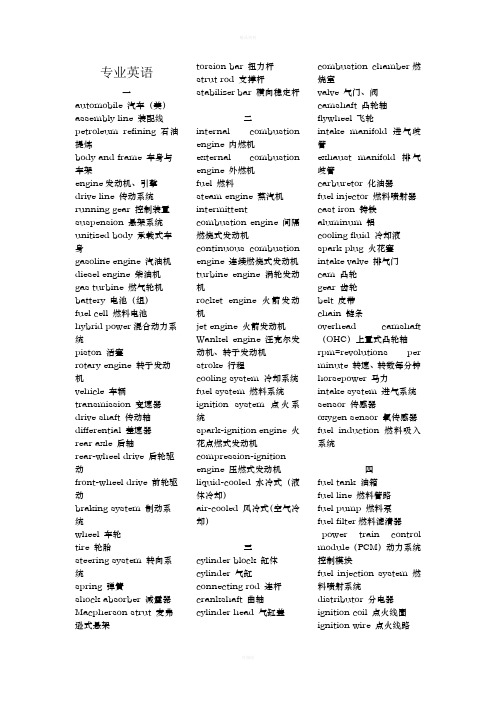
专业英语一automobile 汽车(美)assembly line 装配线petroleum refining石油提炼body and frame 车身与车架engine发动机、引擎drive line 传动系统running gear 控制装置suspension 悬架系统unitized body 承载式车身gasoline engine 汽油机diesel engine 柴油机gas turbine 燃气轮机battery 电池(组)fuel cell 燃料电池hybrid power混合动力系统piston 活塞rotary engine 转子发动机vehicle 车辆transmission 变速器drive shaft 传动轴differential 差速器rear axle 后轴rear-wheel drive 后轮驱动front-wheel drive 前轮驱动braking system 制动系统wheel 车轮tire 轮胎steering system 转向系统spring 弹簧shock absorber 减震器Macpherson strut 麦弗逊式悬架torsion bar 扭力杆strut rod 支撑杆stabilizer bar 横向稳定杆二internal combustionengine 内燃机external combustionengine 外燃机fuel 燃料steam engine 蒸汽机intermittentcombustion engine 间隔燃烧式发动机continuous combustionengine 连续燃烧式发动机turbine engine 涡轮发动机rocket engine 火箭发动机jet engine 火箭发动机Wankel engine 汪克尔发动机、转子发动机stroke 行程cooling system 冷却系统fuel system 燃料系统ignition system 点火系统spark-ignition engine 火花点燃式发动机compression-ignitionengine 压燃式发动机liquid-cooled 水冷式(液体冷却)air-cooled 风冷式(空气冷却)三cylinder block 缸体cylinder 气缸connecting rod 连杆crankshaft 曲轴cylinder head 气缸盖combustion chamber燃烧室valve 气门、阀camshaft 凸轮轴flywheel 飞轮intake manifold 进气歧管exhaust manifold 排气歧管carburetor 化油器fuel injector 燃料喷射器cast iron 铸铁aluminum 铝cooling fluid 冷却液spark plug 火花塞intake valve 排气门cam 凸轮gear 齿轮belt 皮带chain 链条overhead camshaft(OHC)上置式凸轮轴rpm=revolutions perminute 转速、转数每分钟horsepower 马力intake system 进气系统sensor 传感器oxygen sensor 氧传感器fuel induction燃料吸入系统四fuel tank 油箱fuel line 燃料管路fuel pump 燃料泵fuel filter燃料滤清器power train controlmodule(PCM)动力系统控制模块fuel injection system 燃料喷射系统distributor 分电器ignition coil 点火线圈ignition wire 点火线路charging system 充电系统ignition switch 点火开关solenoid 电磁线圈starter motor 起动电机alternator 交流发电机voltage regulator 稳压器lubrication system润滑系统oil pump 机油泵oil filter 机油滤清器oil cooler 机油冷却器antifreeze 防冻液coolant pump 冷却液泵thermostat 节温器radiator 散热器、水箱clutch 离合器radiator overflow tank 散热器溢流箱、膨胀水箱air intake ducting 进气管air filter 空气滤清器manifold air pressure sensor 进气歧管压力传感器turbocharger 涡轮增压器muffler 消声器、消音器catalytic converter 催化转化器exhaust pipe 排气管pollution control system 排放控制系统carbon monoxide 一氧化碳nitrogen oxide 氮氧化物hydrocarbons 碳氢化合物carbon canister 碳罐exhaust gas recirculator (EGR)废气再循环positive crankcase ventilation强制曲轴箱通风diverter valve 分流阀vapor-liquid separator气液分离器vacuum modulator 真空调节器五timing 正时、定时air-fuel ratio 空燃比stoichiometric ratio 理论空燃比mixture 混合气top dead center(TDC)上止点bottom dead center(BDC)下止点bore 气缸直径、孔径crankpin 连杆轴颈、曲柄销throw 曲柄半径displacement 排量compression ratio 压缩比four-stroke engine 四冲程发动机intake stroke 进气冲程compression stroke 压缩冲程power stroke 做功行程exhaust stroke 排气行程preignition 提前点火valve overlap 气门重叠六two-stroke engine 二冲程发动机truck 货车、卡车bus 公共汽车Mercedes-Benz 梅赛德斯奔驰pickup truck 皮卡camper 露营车travel trailer 旅行拖车high-pressure injection高压喷射low-pressure injection低压喷射injector 喷油器、喷嘴psi 磅/平方英寸(英制压强单位)photochemical smog 光化学烟雾outboard motor 舷外发动机snowmobile 摩托雪橇chain saw 链锯、电锯reed valve 簧片阀lubricant 润滑剂、润滑油scavenging 扫气General Motors 通用汽车blower 扫气泵rotor 转子coal-fired 燃煤的、烧煤的nuclear-powered 核动力的drivability 动力性、驱动性能generator 发电机transaxle 变速差速器、联合传动器electronic controller 电子控制器downshift 降档manual transmission手动变速器hydrogen 氢carbon dioxide 二氧化碳oxygen 氧methanol 甲醇spacecraft 航天器、宇宙飞船anode 正极、阳极cathode 阴极、负极七oil pan 油底壳、机油盘water jacket 水套cylinder sleeve 气缸套dry sleeve 干缸套wet sleeve 湿缸套warpage 变形liner 衬套、衬垫bearing 轴承harmonic balancer vibration damper 扭转减震器timing gear 正时齿轮connecting rod journal 连杆轴颈main(bearing)journal主轴颈counterweight 平衡重thrust surface 推力面drive flange 传动法兰盘、凸缘fillet 圆角nose (曲轴)前端pulley 皮带轮air conditioning 空调bearing cap 轴承盖copper 铜lead 铅Babbitt 巴氏合金tin 锡bearing clearance 轴承间隙thrust bearing 推力轴承、止推轴承thrust washer 推力垫圈、止推垫圈piston ring 活塞环compression ring 气环oil control ring 油环piston pin 活塞销lock ring 锁环piston land 活塞顶部heat dam 绝热槽piston head 活塞头部piston skirt 活塞裙部ring groove 活塞环槽piston pin bushing 活塞销衬套ring end gap 活塞销开口间隙ductile iron 球墨铸铁chromium 铬molybdenum 钼torsional ring 扭曲环chrome-plated 镀铬的rod cap 连杆盖bearing insert 轴承衬套八cross-flow head 横流式气缸盖coolant 冷却液head gasket 气缸垫wedge-shapedcombustion chamber 楔形燃烧室hemisphericalcombustion chamber 半球形燃烧室open combustionchamber 开式燃烧室、统一式燃烧室pre-combustionchamber 预燃式燃烧室valve seat 气门座valve guide 气门导管retainer 弹簧座valve spring 气门弹簧high-chrome steel 高铬钢stellite 钴铬钨硬质合金keeper 锁紧装置valve stem 气门杆lifter 挺柱pushrod 推杆rocker arm 摇臂valve train clearance 气门间隙variable valve timing 可变气门正时九oil pressure regulator机油压力调节器main oil gallery 主油道oil screen 机油滤网oil pressure sensor 机油压力传感器dashboard 仪表板sump 机油箱、油底壳baffle 挡板gear-type oil pump齿轮油泵rotor oil pump 转子油泵pressure regulator valve调压阀十water pump 冷却水泵pressure cap 压力水箱盖fan 冷却风扇temperature indicator温度指示器air-cooled system 风冷系统liquid-cooled system 水冷系统transmission cooler 自动变速箱油冷却器expansion tank 膨胀水箱housing 外壳impeller 叶轮、转子hub 轮毂pulley 皮带轮closed cooling system闭式冷却系统十一electronic carburetor 电控化油器fuel vapor line 燃油蒸汽管fuel injector pump 喷油泵nozzle 喷嘴、管嘴plastic 塑料fuel cap 油箱盖filler neck 油箱填充口颈fuel metering unit 油量计量装置mechanical fuel pump 机械燃油泵electrical fuel pump 电动燃油泵fuel pressure regulator 燃油压力调节器injector fuel rail 燃油分配管、燃油轨direct injection system 直接喷射式燃料系统indirect injection system 非直喷式燃料系统port fuel injection(PFI)进气道燃油喷射throttle body injection (TBI)气门体燃油喷射multiple-point fuel injection 多点燃油喷射single-point fuel injection 单点燃油喷射continuous injection 连续喷射十二dry-type air filter 干式空气滤清器exhaust pipe 排气管undercarriage 底盘、下部结构fiberglass 玻璃纤维glass pack muffler 玻璃纤维消声器supercharging system 进气增压系统turbocharger 涡轮增压十三conventional ignitionsystem 传统点火系统primary circuit 初级回路(低压回路)secondary circuit 次级回路(高压回路)ballast resistor 附件电阻、稳流电阻crank 起动、摇转primary winding 初级线圈、一次绕组breaker 断电器secondary winding 次级线圈、二次绕组condenser 电容器arc 电弧distributor cap 分电器盖coil tower 点火线圈顶端接头surge 电涌振荡distributor shaft 分电器轴firing order 点火顺序electronic ignitionsystem 电子点火系统semiconductor 半导体electronic spark timing(EST)电子点火正时ignition control(IC)点火控制hight energy ignition(HEI)module 高能点火模块computer-controlledcoil ignition system 微机控制线圈点火系统electronic ignition(EI)电子点火distributorless ignitionsystem 无分电器点火系统ignition module 点火控制模块direct ignition system直接点火系统cableless EI system 无高压线电子点火系统十四。
汽车专业英语
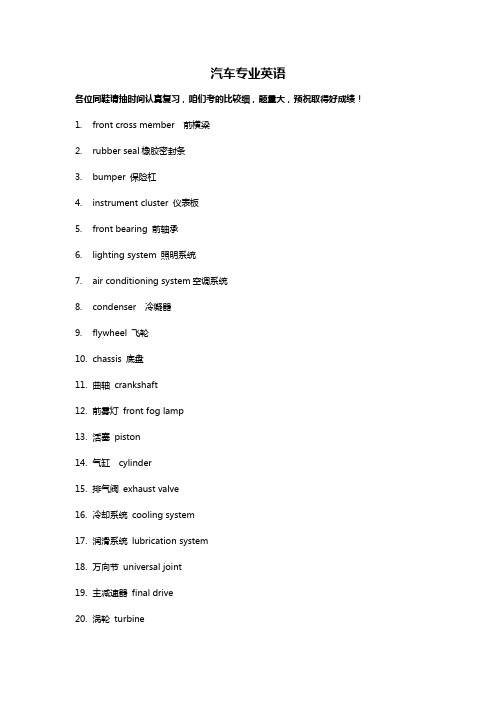
汽车专业英语各位同鞋请抽时间认真复习,咱们考的比较细,题量大,预祝取得好成绩!1.front cross member 前横梁2.rubber seal橡胶密封条3.bumper 保险杠4.instrument cluster 仪表板5.front bearing 前轴承6.lighting system 照明系统7.air conditioning system空调系统8.condenser 冷凝器9.flywheel 飞轮10.chassis 底盘11.曲轴crankshaft12.前雾灯front fog lamp13.活塞piston14.气缸cylinder15.排气阀exhaust valve16.冷却系统cooling system17.润滑系统lubrication system18.万向节universal joint19.主减速器final drive20.涡轮turbine21.rear wheel brake 后轮制动器22.front suspension 前悬架23.spark plug 火花塞24.cylinder cover 气缸盖25.rear bearing 后轴承26.steering shaft 转向轴27.windshield glass 前窗玻璃28.上边梁roof rail29.头枕headrest30.正时齿带timing belt31.仪表板instrument panel32.电子控制系统electronic control system33.differential 差速器34.rectifier 整流器35.螺母nut36.凸轮轴camshaft37.蓄电池accumulator38.engine发动机39.clutch离合器40.switch 开关41.顶灯interior light42.变速器gearbox43.汽油泵gasoline pump44.汽车悬架suspension45.车速表齿轮speed gear46.Center screen 中控屏幕(=Infotainment)47.Inserts 装饰件48.Gearshift 换挡手球49.Handbrake 手刹50.Cup holder 杯托51.Ashtray 烟灰缸52.Lighter 点烟器;打火机53.Button 按键54.Switches 开关(扣的)55.Armrest 肘枕56.Storage 储物空间57.Seat 座椅58.Backrest 靠背59.Cushion 坐垫60.Release handle 扣手61.PWS (power window switches) 玻璃升降器62.Headliner 软顶棚63.Safety belt 安全带64.Map storage地图袋65.bare body 白车身66.battery 电池67.badge 铭牌68.battery piles 蓄电池组69.Be stripped剥离70.bearing 轴承71.Card foot 卡脚72.Beat shield 隔热板73.belt anchorage 安全带固定点74.bumper beam 保险杠加梁75.bench seat 长条座椅76.Board feet 板尺77.bolster 软垫78.Bolt 螺栓79.bracket 支架80.caliper 卡钳81.brake cable 制动拉索82.brake disc 制动盘83.kingpin 主销84.adjusting arm 调节臂85.rim 轮辋86.uplink 上连杆87.damper fork 减震器叉88.torsion bar 扭杆89.vehicle load 车辆负载90.balance bar 平衡杆91.damper 阻尼器92.pneumatic tire 充气轮胎93.bumper 缓冲块94.strut滑柱95.brake master cylinder 制动主缸96.brake line 制动管路97.Brake hose 制动软管98.caliper 卡钳99.brake caliper 制动钳100.brake disc 制动盘101.brake drum 制动鼓102.wheel cylinder 制动分缸103.rotor 转子104.the fuel supply system 燃油供给系统105.fuel tank 燃油箱106.intake manifold 进气歧管107.water tank 水箱108.ignition system 点火系统109.power train system 传动系统110.FF=front engine front drive 前置发动机前轮驱动111.RWD=rear wheel drive 后轮驱动112.transmission/gear box 变速器113.axel shaft 半轴114.drive axle 驱动桥115.shock absorber 减震器116.vehicle body 车身。
汽车专业英语汇总
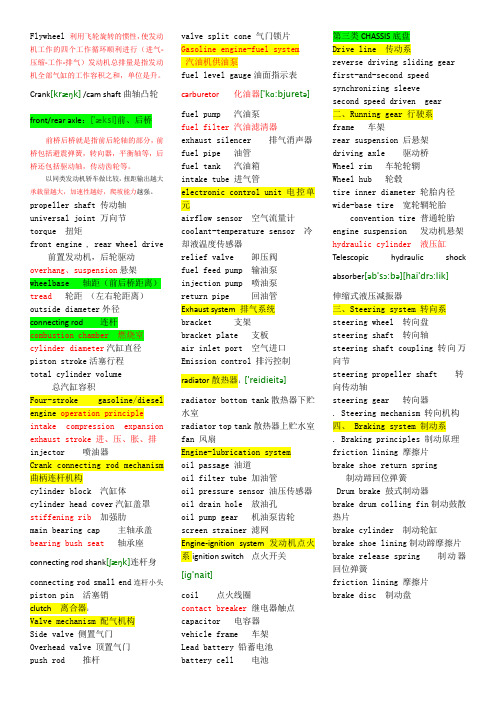
Flywheel 利用飞轮旋转的惯性,使发动机工作的四个工作循环顺利进行(进气-压缩-工作-排气)发动机总排量是指发动机全部气缸的工作容积之和,单位是升。
Crank[kræŋk] /cam shaft曲轴凸轮front/rear axle:['æksl]前、后桥前桥后桥就是指前后轮轴的部分,前桥包括避震弹簧,转向器,平衡轴等,后桥还包括驱动轴,传动齿轮等。
以同类发动机轿车做比较,扭距输出越大承载量越大,加速性越好,爬坡能力越强。
propeller shaft 传动轴universal joint 万向节torque 扭矩front engine , rear wheel drive 前置发动机,后轮驱动overhang、suspension悬架wheelbase 轴距(前后桥距离)tread 轮距(左右轮距离)outside diameter外径connecting rod 连杆combustion chamber 燃烧室cylinder diameter汽缸直径piston stroke活塞行程total cylinder volume总汽缸容积Four-stroke gasoline/diesel engine operation principle intake compression expansion exhaust stroke 进、压、胀、排injector 喷油器Crank connecting rod mechanism 曲柄连杆机构cylinder block 汽缸体cylinder head cover汽缸盖罩stiffening rib加强肋main bearing cap 主轴承盖bearing bush seat轴承座connecting rod shank[ʃæŋk]连杆身connecting rod small end连杆小头piston pin 活塞销clutch 离合器:Valve mechanism 配气机构Side valve 侧置气门Overhead valve 顶置气门push rod 推杆valve split cone 气门锁片Gasoline engine-fuel system汽油机供油泵fuel level gauge油面指示表carburetor 化油器['kɑ:bjuretə]fuel pump 汽油泵fuel filter 汽油滤清器exhaust silencer 排气消声器fuel pipe 油管fuel tank 汽油箱intake tube 进气管electronic control unit 电控单元airflow sensor 空气流量计coolant-temperature sensor 冷却液温度传感器relief valve 卸压阀fuel feed pump 输油泵injection pump 喷油泵return pipe 回油管Exhaust system 排气系统bracket 支架bracket plate 支板air inlet port 空气进口Emission control 排污控制radiator散热器:['reidieitə]radiator bottom tank散热器下贮水室radiator top tank散热器上贮水室fan 风扇Engine-lubrication systemoil passage 油道oil filter tube 加油管oil pressure sensor 油压传感器oil drain hole 放油孔oil pump gear 机油泵齿轮screen strainer 滤网Engine-ignition system发动机点火系ignition switch 点火开关[ig'nait]coil 点火线圈contact breaker继电器触点capacitor 电容器vehicle frame 车架Lead battery 铅蓄电池battery cell 电池第三类CHASSIS底盘Drive line 传动系reverse driving sliding gearfirst-and-second speedsynchronizing sleevesecond speed driven gear二、Running gear 行驶系frame 车架rear suspension 后悬架driving axle 驱动桥Wheel rim 车轮轮辋Wheel hub 轮毂tire inner diameter 轮胎内径wide-base tire 宽轮辋轮胎convention tire 普通轮胎engine suspension 发动机悬架hydraulic cylinder 液压缸Telescopic hydraulic shockabsorber[əb'sɔ:bə][hai'drɔ:lik]伸缩式液压减振器三、Steering system 转向系steering wheel 转向盘steering shaft 转向轴steering shaft coupling 转向万向节steering propeller shaft 转向传动轴steering gear 转向器. Steering mechanism 转向机构四、 Braking system 制动系. Braking principles 制动原理friction lining 摩擦片brake shoe return spring制动蹄回位弹簧Drum brake 鼓式制动器brake drum colling fin制动鼓散热片brake cylinder 制动轮缸brake shoe lining制动蹄摩擦片brake release spring 制动器回位弹簧friction lining 摩擦片brake disc 制动盘。
汽车专业英语
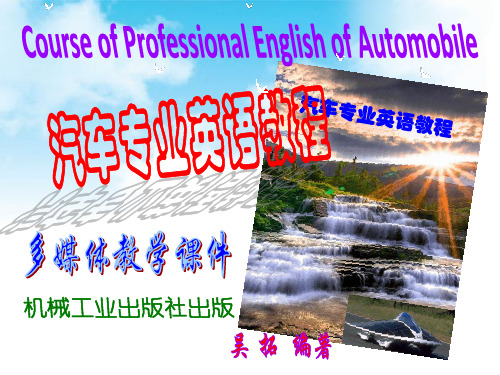
check the water temperature receiver
gauge needle which should indicate“hot”.
检查速度表: ① 用车速表测试仪,
检测车速表的允许 指示误差,并检查 里程表的工作状况。 ② 检查速度表指针
的误差范围:低于 0.5 km/h。
注意:轮胎磨损
和轮胎过分充气或 充气不足均会增加 示值误差。
⑵ 转速表 转速表显示发动
机每分钟的转速。 驾驶时,不要使转 速表的指针指向红 色区,以免发动机 受到损伤。
汽车电气的维修 Unit 14 Car Beauty 汽车美容
Байду номын сангаас
Unit 13 Vehicle Electric Maintenance
汽车电气维修
Section 1 Vehicle Information Displaying System Services
汽车信息显示系统的检修
The vehicle information displaying system is one of the important systems of the automobile.By it,the driver can know whether the cars,especially the various operating parameters of the engine are normal or not in order to take timely measures to prevent the occurrence of physical accident and mechanical accidents.
汽车专业英语汇总
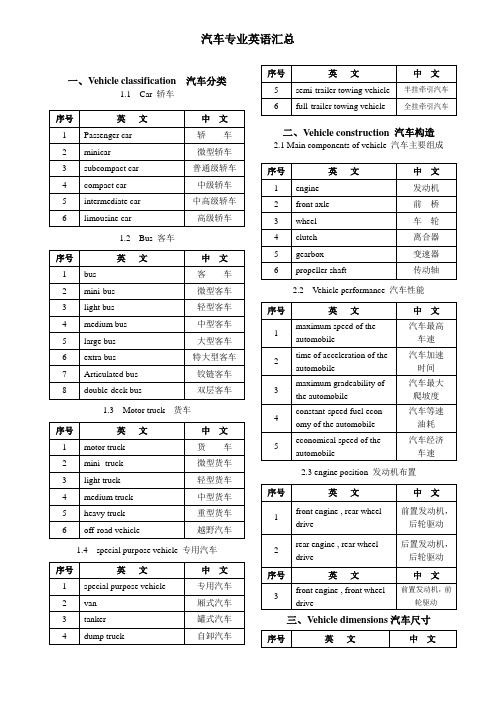
汽车专业英语汇总一、Vehicle classification 汽车分类1.1 Car 轿车1.2 Bus 客车1.3 Motor truck 货车1.4 special purpose vehicle 专用汽车二、Vehicle construction 汽车构造2.1 Main components of vehicle 汽车主要组成2.2 Vehicle performance 汽车性能2.3 engine position 发动机布置三、Vehicle dimensions 汽车尺寸四、ENGINE 发动机Engine-lubrication system 发动机润滑系统 Engine-ignition system 发动机点火系其他:汽车种类diesel 柴油机limousine 豪华轿车drophead 活动车篷汽车racing car 赛车saloon 轿车roadster 敞蓬车beat-up car, jalopy 老爷车notchback 客货两用车four-wheel drive 四轮驱动front-wheel drive 前轮驱动trailer 拖车station wagon 小旅行车truck 卡车compact car 小型汽车light-van 小型货车garbage truck 垃圾车automobile carrier 货运卡车fire engine 消防车tractor 牵引车ambulance 救护车taxi 出租车, 计程车trailer truck 拖车sports car 跑车formula car 方程式赛车, 方程式汽车mail car 邮车jeep 吉普车bloodmobile 血浆车bumper car 碰撞用汽车camper 露营车police car 警车wrecker 清障车ambulance 急救车汽车外设front wheel 前轮rear wheel 后轮tread 轮距chassis 底盘bodywork, body 车身rear window 后窗玻璃windscreen 挡风玻璃windscreen wiper 雨刮器fender, wing, mudguard 挡泥板radiator grille 水箱wing mirror 后视镜bonnet 发动机盖boot 行李箱roof rack, luggage rack 行李架license plate, number plate 车号牌wing 前翼子板hubcap 轮毂罩bumper 保险杠front blinker 前信号灯taillight, tail lamp 尾灯backup light, reversing light 倒车灯stoplight, stop lamp 刹车灯rear blinker 转弯指示灯trunk, boot 行李箱bumper 保险杠tailpipe 排气管汽车内部first gear 一档second gear 二档reverse 倒车档two-stroke engine 二冲程发动机back seat, rear seat 后座driver’s seat, driving seat 驾驶席passenger seat 旅客席steering wheel, wheel 方向盘rear-view mirror, driving mirror 后视镜horn, hooter 喇叭choke 熄火装置gear stick, gear change 变速杆gearbox 变速箱[starter, self-starter 起动器,起动钮brake pedal 刹车踏板clutch pedal 离合器踏板hand brake 手制动器foot brake 脚制动器dashboard 仪表板milometer 里程表speedometer, clock 速度表transmission 传动piston 活塞radiator 散热器shaft 传动轴drain tap 排气阀门silencer 消音器tank 油箱overflow 溢流孔valve 阀门exhaust pipe 排气管spare wheel 备胎,备用轮胎carburetor 汽化器。
常用汽车专业英语汇总

1 ACC activated carbon canister 活性碳罐2 ACI automatic car identification system 汽车自动识别系统3 air cushion car 气垫车4 air-cooled car 空气冷却式汽车,空冷式车辆,空冷式轿车(装用空冷式发动机的轿车)5 APC aperture card 穿孔卡片6 ASU automatic interference suppression for car radios suppresses igni tion noise in the FM band 调频干扰自动抑制,在汽车收音机中附加入此电路即可抑制高压点火(噪音)的干扰7 baby car 微型轿车,超微型轿车(美俚语,=mini car,cycle car,midget car);婴儿小车8 backfiring in carburetor 化油器回火(=explosion in the carburetor)9 baggage car 行李车10 brake shoe carrier 制动蹄座11 brush carrier 刷架12 C&M care and maintenance 维修和保养13 C.CARB conventional carburetor 常规化油器14 C.P. car park (停)车场15 C/O carry over 携带16 cable-testing car 电缆检查车17 car aerial 汽车天线(=automobile aerial)18 Car Alarm theft-deterrent system 汽车防窃警报系统19 car antenna 车上天线,车载天线,汽车天线20 car body 轿车车身21 car mechanic 汽车维修工,机动车维修工22 car navigation computer 车用导航计算机,车用导行计算机23 car park 停车场,停车处24 car waiting to repair 待修汽车25 car wander 汽车蛇行26 car wash 洗车台,汽车清洗站27 car wash trade 洗车业28 car washer 洗车设备,洗车机;街道清洗机29 car washing department 洗车工间,车辆清洗工间30 car washing installation 洗衣装置,洗车设备31 car washing installation 洗衣装置,洗车设备32 car washing machine 洗车机33 car with elevator 带升降机车辆,升降机汽车34 car with four independent wheels 四轮独立悬架式轿车35 carb 化油器,汽化器(carburator的简称)36 CARB 1.化油器(carburettor) 2.碳化,渗碳(carbonization)37 carb adjustment 化油器调准,化油器调节38 CARB California Air Resources Board 加里福尼亚大气资源局39 CARB carburetor 化油器,汽化器40 carboard 纸板,硬纸板41 carbon 碳(代号C);碳棒,电刷,石墨,积炭,积碳层42 carbon electrode 碳棒,碳电极43 carbon monoxide 一氧化碳(CO)44 carbonization test (润滑油)积炭试验45 CARE corporate average regulated emission 公司规定的平均有害物排放量46 CARP cooperate automotive research program 汽车合作研究程序47 CARR carriage 车溜板48 CARR carrier 运载工具,载体49 carriage 车辆,车架,支架,托架;(机床的)拖板;机器的滑动部分;底座,底盘;承重装置,承载器;运输,运费50 carriage body 车身51 CARS computer aided routing system 计算机辅助(运输网络中)选线系统52 CART carton 卡片纸53 cartridge 管壳,盒;卡盘,夹头;座;套筒;衬套(过滤器的)芯子;(照像)胶卷;支架54 cartridge fuse 熔断丝管,熔断丝55 cartridge paper 画图纸,图画纸56 CAT carburetor air temperature 化油器空气温度57 CFC chlorofluorocarbons 含氯氟烃(氟属致冷剂)58 CFRC carbon fiber friction material 碳纤维摩擦材料59 CFRP carbon fiber reinforced plastic 碳纤维强化塑料60 CL car load 车辆载负61 CLCC closed loop carburetor control 闭环化油器控制62 CO carbon monoxide 一氧化碳63 CO2 carbon dioxide 二氧化碳64 COEI carbon-monoxide emission index 一氧化碳排放指数65 COF container-on-flt car 平板车装运集装法,集装箱在平板货车上的运输方法66 convertible car 活顶篷轿车67 COTY car of year 当年(流行)的汽车,年款汽车68 CP car post 停车场69 CPT carpet 地毯70 CR carriage return 回车71 CUCV commercial utility cargo vehicle 商用,轻型,多用途载货汽车72 DCCSC divided-chamber carbureted stratified-charge engine 分隔式燃烧室混合气层状充气发动机73 diaphragm carburettor 膜片式化油器74 diesel-engined passenger car 柴油(发动)机客车,柴油机轿车75 differential carrier 差速器壳(=differential case,differential housing)76 dismantling from car to units 汽车拆成部件,汽车拆成总成77 drill carriage 钻轴滑座78 ECC electronically controlled carburetor 电子控制的化油器79 ECC-CU (control unit) electronically controlled carburetor control unit 电子控制的化油器控制装置80 EFC electronic fecdback carburetor 电子反馈式控制化油器(电脑根据排气管中O2传感器信号,自动调节空燃比)81 EFC electronic fuel controlled carburetor 电子燃油控制化油器82 EIC carbon emission index 碳排放量指数83 electronically controlled carburetor 电脑控制化油器,电子控制式化油器(简称ECC)84 electronically controlled carburetor-control unit 电子控制式化油器的电子控制器(简称ECC-Control unit)85 emissions carburetor 防污染化油器86 enclosed cardan shaft 封闭式传动轴(=encased propeller shaft)87 EOHC engine-out hydrocarbon 发动机排出的碳氢化合物88 explosion in carburetor 化油器回火(放炮)89 explosion in the carburettor 化油器回火(=backfiring in carburetor,blowback,popping back)90 exposed cardan shaft 开式万向传动轴;开式甲唐轴91 fast back car 斜背式轿车92 FBC feedback carburetor 反馈控制式化油器93 float carburettor 浮子式化油器94 float of carburettor 化油器,浮子95 forecarriage (挂车)前转向架96 four door convertible car 四门车篷可折叠式轿车97 four-tire car 四轮胎轿车(指使用被尖物刺穿或放炮漏气后仍能继续行驶的轮胎,因而不再需要备用胎的的汽车)98 front-wheel-drive car 前轮驱动轿车(简称f-w-d car)99 fuel-cell car 燃料电池(驱动的)轿车(1996年5月14日,由Mercedes-Benz公司在柏林展出世界上第一辆氢燃料电池轿车,系将甲醇在车上通过一个专门的反应器,产生H2和CO2,接着将H2导入一个聚合物电池,在触媒的作用下,与空气反应,产生H2O和电流,用电流驱动车辆)100 f-w-d car 前轮驱动轿车(front-wheel drive car)101 general purpose car 万能车,万用车,多用途车,多功能轿车(如全轮驱动的北京切诺基轿车)102 GPC glass carbonate composite 玻璃聚碳酸酯复合材料103 GT grade touring car 跑车104 GT grand touring car 豪华高速旅游车105 H/C fuel hydrogen/carbon ratio 燃油中(烃的)氢碳比106 H/C hydrogen/carbon (烃的)氢碳比107 HC hydrocarbon 碳氢化合物108 H-Carb Hitachi 2Bbl carburetor (日本Hitachi)两腔化油器109 HCEI hydrocarbon emission index 碳氢化合物排放指数110 HCS high carbon steel 高碳钢111 HCSHT high carbon steel heat treated 热处理过的高碳钢112 HPSiC hot-pressed silicon carbide 热压碳化硅113 IFC carb integrated fuel control carburetor 综合控制供油化油器114 implement carrier 机具运载装置,通用机架115 instrument carrier panel 仪表板(=instrument board)116 instrument carrier plate 仪表板(=instrument board)117 insulating carton 绝缘纸板118 intelligent car 智能化汽车,无人驾驶汽车,智能轿车(指运用计算机技术、电子技术、信息技术,使汽车能以最佳路线,最佳工况行驶,且能在自动公路上无人驾驶,自动行驶)119 intercar radio 汽车之间的无线电通讯装置,车间无线电通讯装置120 ISCO indicated specific carbon monoxide 指示马力一氧化碳排放率(量) 121 ITC international touring car championship 国际旅游(游览)轿车冠军122 jet carburetor 喷雾式化油器123 KDC knock down car 就地装配的汽车,当地组装的汽车124 KDCL knock down in carloads (货物)以散装状态装车125 laggage carrier (车内)行李架,行李搬运车(=bag-gage carrier)126 lamp carrier 灯座127 LCL less-than-carload 零担的(货运)128 lining of car 车身衬里129 load-carrying 承载负荷的,承载的,承重的130 long base car 长轴距轿车131 luggage carrier 行李箱,行李架132 luggage carrier extension (汽车)行李架的延长部分133 luggage carrying capacity 行包承载能力,行李容量(=luggage capacity) 134 M.CARB modified carburetor 改进的化油器135 main carburettor 主化油器136 microprocessor controlled car 微机控制轿车(一般指微机控制点火、喷油、变速的轿车)137 motor car mechanic(ian) 轿车技工,轿车技师,轿车机械技术员(=automobile mechanic)138 motorcar headlamp 汽车前照灯(=automobile headlamp)139 motorcar horn 汽车喇叭,轿车用喇叭140 motorcar owner 轿车车主141 motorcar radio set 汽车收音机(亦称motorcar set)142 motorcar repair shop 汽车修理场,轿车修理车间,轿车检修站143 motorcar rim 小汽车轮辋,轿车轮辋144 motorcar set 轿车收音机(=autoradio,automobile radio set,car radio receiver,car radio set,automobile receiver)145 mounted load carrier 悬挂式装载车146 multicylinder car 多缸发动机汽车147 multi-nozzle carburetor 多喷油嘴式化油器(指化油器除主喷油嘴外,还有辅助喷油嘴,以适应高速、加速等工况用)148 multi-throat carburetor 多腔化油器(=multibarrel,carburetor)149 NFB non feedback carburetor 无反馈式化油器150 Nissan Bluebird car 日产鸟蓝轿车(日本)日产公司1992年推出两种不同车身的蓝鸟轿车ARX-G,SSS-G,装用4缸发动机,排量2000ml,最大功率107kw,前轮驱动,可在挡风玻璃左上角显示行车速度和有关安全行车的指示)151 Nissan Figaro car 日产费加罗轿车(日本日产公司1991年推出的微型轿车.装用SOHC涡轮增压发动机,排量387ml,最大功率56kW,自动变速,可折叠式软车顶) 152 NMHC non-methane hydrocarbon(emission) 不含甲烷的碳氢化合物(排放) 153 oil pump carrier 油泵泵壳,油泵托架,油泵小车154 one way car 一次性轿车,便宜轿车,低级轿车155 orthodox car 传统汽车,正统汽车,普通汽车,一般汽车156 PAH poly cyclic aromatic hydrocarbon (发动机的)多环芳香族碳氢化合物(排放物)157 PAH poly-aromatic hydrocarbon (发动机的)芳烃碳氢化合物(排放物)158 passenger(-car)rim 轿车轮辋159 passenger-car chassis 轿车底盘160 passenger-carrying chassis 客车底盘(一般指大客车底盘)161 PC polycarbonate 聚碳酸酯162 PCAH polycyclic aromatic hydrocarbons 多环芳香族碳氢化合物163 petrol-electric car 汽油-电动车辆164 PGM-CARB programmed carburetor 可编程的化油器,电脑控制化油器165 piston ring carrier 活塞环槽镶座(=ring carrier)166 planet carrier 行星齿轮架,行星架167 planet wheel carrier 行星齿轮轴架168 planetary gear carrier 行星齿轮架169 planetary pinion carrier (行星齿轮机构的)行星架(=planet carrier)170 popping in carburettor 化油器放炮,化油器回火(back firing in carburettor,popping-back)171 posh car 最漂亮的轿车(英俚),豪华轿车172 premier car company 第一流的轿车公司,名列前矛的汽车公司173 primary carburetor 初级化油器,一级化油器(除高速、大负荷下使用二级化油器外,其他常用工况都使用一级化油器,亦称primary side)174 RC power car rotary combustion power car 转子发动机汽车175 rear-engine car 后置发动机轿车,发动机后置式汽车176 rear-steering car 后轮转向车177 remoulded car 改造的汽车;改装的汽车;改型汽车178 right hand control car 右转向盘车辆,右座驾驶车辆(用于靠左行驶的国家,=right hand drive car)179 ring groove carbon remover 活塞环槽积炭清除工具180 roof stick carline (木制厢式货车车身的)横顶梁,拱梁181 safety car 安全汽车(指碰撞时,乘员不致遭受重大伤害的轿车,目前处于试验阶段)182 saloon car 普通轿车(双排座轿车,驾驶员座与乘客间无隔板,=closed car,简称saloon,美国称sedan)183 scraped car 报废汽车,废车184 seal cartridge 密封衬套185 secondary carburetor 次级化油器,二级化油器(在高速、大负荷下使用的双级化油器的第二级,亦称secondary side)186 sedan car 轿式小客车,轿车187 semitrailer pole carriage 杆式半挂车188 SHF synthesized hydrocarbon fluid 合成烃润滑189 sightseeing car 游览客车,观光汽车190 SISIC silicon carbide reaction-sintered 反应烧结碳化硅191 solar car 太阳能汽车,太阳能轿车(=solar powered car)192 sonic-nozzle carburetor 声速喷嘴化油器193 spare wheel carrier 备胎架194 special passenger car 特种轿车(特种用途的轿车,如检阅车,指挥车)195 spring carrier 钢板弹簧支架196 spring carrier arm 弹簧托架197 SSIC silicon carbide pressureless-sintered 不加压烧结碳化硅198 steam-powered car 蒸汽动力汽车,蒸汽机汽车199 steam-powered motor-car 蒸汽动力汽车,蒸汽机汽车200 straight-eight car 直列八缸发动机汽车201 streamlined car 流线型汽车202 streetcar detector 有轨电车探测器203 SU carburetor,skinner union SU化油器204 subcarrier 副载波205 subcompact car 普通级轿车,小型轿车,(发动机排量大于IL且小于或等于1,6L)206 super car 超级车,超级汽车(特指使用高级汽油的高压缩比发动机的轿车) 207 supercarburize 使混合气过渡208 supercharged car (废气涡轮)增压式汽车209 SV-CBV solenoid valve carburetor bowl vent 化油器浮子室通风电磁阀210 televsion car 电视车211 THC total hydrocarbon 碳氢化合物总量(排放物中)212 tilt car 前翻式驾驶室(tilting cab)213 tow car 牵引车,拖车;拖走故障车的救援车(=tow truck)214 TPHC tail pipe hydrocarbon 排气尾管碳氢化合物215 track carrying wheel (履带行走装置)托链轮(=carrying wheel,upper track wheel)216 track scarifier 轮迹消除器,轮辙扒松器217 tracked cars 履带车,履带式车辆218 trunk carrier 行李舱支架,行李搬运车219 twin-choke carburetor 双风门化油器,双阻风门化油器220 two jet carburetor 双喷嘴化油器221 two-door car 双门轿车,两门轿车(左右两侧各一个车门)222 UBHC unburned hydrocarbons (发动机中)未燃尽的碳氢化合物223 under carriage 底架,脚架;起落架,下支架,(车辆的)行走部分(机构)224 unitized car 承载式车身轿车,整体式车身轿车(=frameless car,stressed-skin car,unitary car,single unit car,monocoque car)225 unitized carrier-type axle housing 整体式桥壳(将减速器壳与轴壳的中间部分铸成一体,两端压入无缝钢管后,用塞焊将其与中间部分焊接在一起)226 USE universal small car engine 通用小型车用发动机227 vaporizing carburet(t)or 蒸发式化油器,汽化式化油器228 variable-area carburetor 活动喉管化油器,可变喉管断面化油器(=variable-venturi carburetor)229 variable-choke carburetor 可变喉管化油器(variable-venturi carburetor) 230 variable-stability car (专供试验用的)稳定性可变的轿车231 variable-venturi carburetor 可变喉管化油器,活动喉管化油器232 VCC variable characteristic car 可变特性轿车233 VRC variable research car 多变型车234 VTV variable-venturi(carburetor) 可变喉管(化油器)235 VV variable-venturi(carburetor) 可变喉管(化油器)236 WC with care 小心(货运包装标志)237 weight of car 车重(缩写WOC)238 wireless car 带无线电装置的汽车239 WOC weight of car 车重240 WORKCAP working capacity of activated carbon (吸收汽油蒸汽的)活性碳工作容量241 WTCARB weight of activated carbon required 活性碳需求量。
汽车专业英语

led by an electric motor powered by rechargeable battery packs.The Battery Electric Vehicle,for short BEV,
cal machinery control technology development,must be replaced by direct current the electric motor (BCEM),the switch magnetic resistance electric
internal combustion engine automobile
of the electric automobile works only produces the waste gas,have not the exhaust pollution . It is extremely
beneficial to protect the environmental and the air , so it has Laudatory of “ Zero-pollution ” . Electric motors
Environmentally friendly.EVs emit no tailpipe pollutants , al-
though the power plant producing the electricity may emit them.Electricity from nuclea- , hydro- , solar- , or wind-powered plants causes no air pollutants.
汽车专业英语词汇

1.accelerator positionsensor [æk seləreitə][pəziʃən] [sensə]油门位置传感器2.audio control switch[ɔ:djəu] [kəntrəul][switʃ]音响控制开关3.automatic level control[ɔ:təmætik] 自动水平控制装置4.automotive engine system引擎系统5.axle shaft [æksl] 车(主动)轴6.base plate 底盘7.battery [bætəri]蓄电池8.bearing [bɛəriŋ]轴承9.body 车体10.bolt [bəult] 螺栓11. bolt cap 螺栓帽12.bolt-fly wheel [hwi:l]飞轮螺栓13.brake system 剎车系统14.breathe pipe [bri:ð]通气管15.CD player CD机16.Center shaft [sentə][ʃɑ:ft] 中间轴17.clamp [klæmp]卡座18.clamp plate 压板19.clutch [klʌtʃ] 离合20.clutch system 离合器21.coil spring [kɔil]螺旋簧bustion chamber [kəmbʌstʃən] [tʃeimbə]燃烧室23. commutator [kɔmjuteitə]转换器pression spring[kəmpreʃən]压簧pressor 压缩机26.condenser [kəndensə]冷凝器27.connecting rod 连杆28.cooling system 冷却系统29.crank shaft [kræŋk] 曲轴30.cylinder block [silində]汽缸体31.cylinder block汽缸体32.cylinder sleeve [sli:v]气缸套33.displacemint 排气量34.Double end bolt [dʌbl][bəult]双头螺母35.dowel pin [dauəl] [pin]柱销36.drive shaft 传动轴37.dust shield [ʃi:ld] 防尘罩38.electrical equipment(appliance)[i lektrikəl][i kwipmənt] [əplaiəns] 电气设备39.end cover 端盖40.engine [endʒin]发动机41.exhaust valve [iɡzɔ:st][vælv]排气门42.fire extinguisher [ikstiŋɡwiʃə]灭火器43.flywheel 调速轮,飞轮44.four-wheel drive 四轮驱动45.fram assy 车架总成46.Front cover [frʌnt] [[kʌvə] 前盖47.Front Engine Front Drive F.F.式车辆48.Front Engine Rear Drive F.R.式车辆49.fuel filler pipe assy [fjuəl] [filə] [paip]加油管总成50.fuel inlet hose [inlet] [həuz] 进气硬管51.fuel level indicator [indikeitə] 汽油表52.fuel return pipe [ritə:n] 回油管53.fuel transfer pump [træns fə:] [pʌmp] 输油泵54.gasket [ɡæskit]密封垫55.gear lever [ɡiə] 操纵杆,变档杆56.generator [dʒenəreitə] 发动机57.handle [hændl] 手柄58.headlamp 头灯59.heat insulator [insjuleitə] 隔热板60.heat shield subassy 隔热罩组件61.heat-control valve 热控制阀62. hex bolt [heks] [bəult] 六角头螺栓63.high pressure pump [preʃə]高压油泵64.houseing [hauziŋ] 壳体,外壳65.identification code [aidentifikeiʃən]标记66.idle mixture screw [aidl] [mikstʃə] [skru:] 怠速混合气调整螺钉67.idle tube [tju:b]怠速油管68.idling speed 怠速69.ignition coil type 点火线圈类型70.ignition coil [iɡniʃən]点火线圈71.ignition controller kəntrəulə]点火控制器72.ignition key 点火钥匙73.ignition point 燃点74.ignition switch 点火开关75.ignition switch assy [iɡniʃən] [switʃ] 点火开关总成76.ignition System 点火系77.ignition wire [waiə]点火线78.impact reduction type outside rear view mirrors[ridʌkʃən] [riə]缓冲式后视镜79.impact test 冲击试验80.imported motor vehicle [vi:kl]进口机动车81.indicator lamp 指示灯82.indicator lamp, left turn 左转向指示灯83.indicator lamp, right turn 右转向指示灯84.indirectly controlled wheel 间接控制车轮85.injection nozzle 喷油嘴86.injection pump [indʒekʃən] 喷油泵87.injector 喷油器88.inlet hole 进气孔89.inlet hose[həuz] 进风口90.inlet opening 进油口91.inlet tube 进油管92.inlet valve 进油阀93.inlet 进油口94.inner dimension 内部尺寸95.inner shaft 内半轴96.inner tube 内胎97.input shaft 输入轴98.input voltage [vəultidʒ]输入电压99.install panel [pænəl]安装板100.instrument panel assy. [instrumənt] [pænəl]仪表板总成101.instrument panels 仪表板102.intake and exhaust device [iɡzɔ:st]进排气装置103.intake heater 进气加热器104.intake manifold [mænifəuld]进气歧管105.intake valve 进气门106.intercooler [intə(:)ku:lə]中冷器107.intermediate plate [ɪntəmi:djət] 中联板108.intermediate shaft 中间轴109.internal fan [intə:nəl]内风扇110.in-use motor vehicles 在用车辆111.joint [dʒɔint] 接头112.knock 敲击rge-sized special 大型专用teral level 横向水平仪115.left fog lamp 左雾灯116.left headlamp 左前照灯117.left horn[hɔ:n] 左喇叭118.left steering [stiə]左转向119.left tail lamp 左尾灯120.length, width and height 全长、全宽、全高121.let in air 进气122.license lamp [laisəns]牌照灯123.light vehicles 轻型车辆124.lighting device 照明装置125.lighting system 照明系统126.lining 衬片127.loaded goods 装载物128.loading capacity [kəpæsiti]载重量129.loading platform [plætfɔ:m]货箱130.locating block [ləukeit] 限位块131.locating shaft 限位轴132.locking device 锁止装置133.logo-Great Wall motor in Chinese 长城汽车标牌134.long axis [æksis]长轴135.long-body 长车身136.lower pressure switch 低压开关137.lubricating oil [lu:brikeit]润滑油138.magnet [mæɡnit] 磁体139.main bearing [bɛəriŋ]主轴承140.main bearing 主轴承141.main injection jet [dʒet]主喷口142.main oil gallery [ɡæləri]主油道143.main spring 主簧144.Make and type 厂牌和型号145.management supervisor 主管人146.manual transmission [trænz miʃən]手动变速器,手排挡变速箱147.manufacturer [mænjufæktʃərə]制造者148.marker lamp, left front 左前示廓灯149.marker lamp, right front 右前示廓灯150.master cylinder body 制动主缸缸体151.master cylinder cover 制动主缸缸盖152.max power 最大功率153.maximum loading capacity [mæksiməm] [kəpæsiti]最大载重量154.maximum output 最大输出功率155.measuring tape 卷尺156.mechanical steering 机械转向器157.metering rod 计量杆158.microphone 话筒159.mini-sized motor vehicle 小型机动车160.mini-sized 微型161.mirror for immediate front obstacle 前邻障碍观察镜162.motor vehicle category 机动车类别163.motor vehicle 机动车164.motor-driven cycle 摩托车165.nut 螺母166.oil block plate 挡油板167.oil drain groove [drein] [ɡru:v]导油槽168.oil filter [filtə]机油滤清器169.oil filter机油滤清器170.oil guide nozzle [nɔzl] 导油嘴171.oil pressure gauge [ɡeidʒ]机油压力表172.oil pump 机油泵173.oil trough [trɔ(:)f] 油槽174.overall height 总高175.overall length 总长176.overall width 总宽177.ping 爆声178.piston [pistən]活塞179.plastic nut [plɑ:stik] 塑料螺母180.Power 电源181.power steering 动力转向182.push rod 推杆183.radiator 散热器184.radiator fan [reidieitə]散热风扇185.regulator [reɡjuleitə]调整器186.return spring 复位弹簧187.reverse gear lever [rivə:s][ɡiə] 倒档拨杆188.revolution transmitter [revəlu:ʃən] [trænz mit] 转速传感器189.rivet [rivit] 铆钉190.roof handle 车顶扶手191.rotating shaft [rəuteit] 转轴192.rub hose [həuz]橡胶管193.screw [skru:]螺钉194.seal ring [si:l] 密封环195.seat belt 安全带196.self lock spring 自锁弹簧197.shaft-shifting fork 换档轴198.shaft-shifting fork [fɔ:k] 变速叉轴199.shift rocker [rɔkə]换档摇臂200.shifting block [ʃift] [blɔk] 换档拨块201.Shifting fork NO.1 一号拨叉202.shifting shaft 换挡轴203.shim [ʃim] 垫片204.shock absorber 避震器205.side cover 侧盖206.spacing spring [speisiŋ]限位弹簧207.spark plug 火星塞208.spark wire 高压电线209.Speaker 扬声器210.speedometer drive [spidɔmitə]速率表211.splint [splint] 夹板212.sponge cushion [spʌndʒ] [kuʃən]海绵垫213.stabilizer bar 平稳杆214.starting motor 起动马达215.steering wheel assembly [əsembli] 方向盘总成216.sunroof 天窗217.switch 开关218.tail door glass 后背门玻璃219.temperature control switch [tempəritʃə] [kəntrəul] 温度控制开关220.tie band 扎带221.tire size 轮胎尺寸222.tire tube 内胎223.vacuum pipe [vækjuəm]真空管224.vacuum regulatory [reɡjuleit]真空调节器225.ventilation plug [ventileiʃən] 通气塞226.vibration damper 减震器227.waste gate 废汽门228.water pump 水泵229. wheel 车轮230.wheel balance 轮胎平衡231.wheel rim 钢圈232.wheel rim, tire 钢圈与车胎。
汽车专业英语

专业英语一automobile 汽车(美)assembly line 装配线petroleum refining石油提炼body and frame 车身与车架engine发动机、引擎drive line 传动系统running gear 控制装置suspension 悬架系统unitized body 承载式车身gasoline engine 汽油机diesel engine 柴油机gas turbine 燃气轮机battery 电池(组)fuel cell 燃料电池hybrid power混合动力系统piston 活塞rotary engine 转子发动机vehicle 车辆transmission 变速器drive shaft 传动轴differential 差速器rear axle 后轴rear-wheel drive 后轮驱动front-wheel drive 前轮驱动braking system 制动系统wheel 车轮tire 轮胎steering system 转向系统spring 弹簧shock absorber 减震器Macpherson strut 麦弗逊式悬架torsion bar 扭力杆strut rod 支撑杆stabilizer bar 横向稳定杆二internal combustion engine 内燃机external combustion engine 外燃机fuel 燃料steam engine 蒸汽机intermittent combustionengine 间隔燃烧式发动机continuous combustionengine 连续燃烧式发动机turbine engine 涡轮发动机rocket engine 火箭发动机jet engine 火箭发动机Wankel engine 汪克尔发动机、转子发动机stroke 行程cooling system 冷却系统fuel system 燃料系统ignition system 点火系统spark-ignition engine 火花点燃式发动机compression-ignition engine压燃式发动机liquid-cooled 水冷式(液体冷却)air-cooled 风冷式(空气冷却)三cylinder block 缸体cylinder 气缸connecting rod 连杆crankshaft 曲轴cylinder head 气缸盖combustion chamber燃烧室valve 气门、阀camshaft 凸轮轴flywheel 飞轮intake manifold 进气歧管exhaust manifold 排气歧管carburetor 化油器fuel injector 燃料喷射器cast iron 铸铁aluminum 铝cooling fluid 冷却液spark plug 火花塞intake valve 排气门cam 凸轮gear 齿轮belt 皮带chain 链条overhead camshaft(OHC)上置式凸轮轴rpm=revolutions per minute转速、转数每分钟horsepower 马力intake system 进气系统sensor 传感器oxygen sensor 氧传感器fuel induction燃料吸入系统四fuel tank 油箱fuel line 燃料管路fuel pump 燃料泵fuel filter燃料滤清器power train control module(PCM)动力系统控制模块fuel injection system 燃料喷射系统distributor 分电器ignition coil 点火线圈ignition wire 点火线路charging system 充电系统ignition switch 点火开关solenoid 电磁线圈starter motor 起动电机alternator 交流发电机voltage regulator 稳压器lubrication system润滑系统oil pump 机油泵oil filter 机油滤清器oil cooler 机油冷却器antifreeze 防冻液coolant pump 冷却液泵thermostat 节温器radiator 散热器、水箱clutch 离合器radiator overflow tank 散热器溢流箱、膨胀水箱air intake ducting 进气管air filter 空气滤清器叮叮小文库manifold air pressure sensor 进气歧管压力传感器turbocharger 涡轮增压器muffler 消声器、消音器catalytic converter 催化转化器exhaust pipe 排气管pollution control system 排放控制系统carbon monoxide 一氧化碳nitrogen oxide 氮氧化物hydrocarbons 碳氢化合物carbon canister 碳罐exhaust gas recirculator (EGR)废气再循环positive crankcase ventilation 强制曲轴箱通风diverter valve 分流阀vapor-liquid separator 气液分离器vacuum modulator 真空调节器五timing 正时、定时air-fuel ratio 空燃比stoichiometric ratio 理论空燃比mixture 混合气top dead center(TDC)上止点bottom dead center(BDC)下止点bore 气缸直径、孔径crankpin 连杆轴颈、曲柄销throw 曲柄半径displacement 排量compression ratio 压缩比four-stroke engine 四冲程发动机intake stroke 进气冲程compression stroke 压缩冲程power stroke 做功行程exhaust stroke 排气行程preignition 提前点火valve overlap 气门重叠六two-stroke engine 二冲程发动机truck 货车、卡车bus 公共汽车Mercedes-Benz 梅赛德斯奔驰pickup truck 皮卡camper 露营车travel trailer 旅行拖车high-pressure injection 高压喷射low-pressure injection低压喷射injector 喷油器、喷嘴psi 磅/平方英寸(英制压强单位)photochemical smog 光化学烟雾outboard motor 舷外发动机snowmobile 摩托雪橇chain saw 链锯、电锯reed valve 簧片阀lubricant 润滑剂、润滑油scavenging 扫气General Motors 通用汽车blower 扫气泵rotor 转子coal-fired 燃煤的、烧煤的nuclear-powered 核动力的drivability 动力性、驱动性能generator 发电机transaxle 变速差速器、联合传动器electronic controller 电子控制器downshift 降档manual transmission 手动变速器hydrogen 氢carbon dioxide 二氧化碳oxygen 氧methanol 甲醇spacecraft 航天器、宇宙飞船anode 正极、阳极cathode 阴极、负极七oil pan 油底壳、机油盘water jacket 水套cylinder sleeve 气缸套dry sleeve 干缸套wet sleeve 湿缸套warpage 变形liner 衬套、衬垫bearing 轴承harmonic balancer vibrationdamper 扭转减震器timing gear 正时齿轮connecting rod journal 连杆轴颈main(bearing)journal主轴颈counterweight 平衡重thrust surface 推力面drive flange 传动法兰盘、凸缘fillet 圆角nose (曲轴)前端pulley 皮带轮air conditioning 空调bearing cap 轴承盖copper 铜lead 铅Babbitt 巴氏合金tin 锡bearing clearance 轴承间隙thrust bearing 推力轴承、止推轴承thrust washer 推力垫圈、止推垫圈piston ring 活塞环compression ring 气环叮叮小文库oil control ring 油环piston pin 活塞销lock ring 锁环piston land 活塞顶部heat dam 绝热槽piston head 活塞头部piston skirt 活塞裙部ring groove 活塞环槽piston pin bushing 活塞销衬套ring end gap 活塞销开口间隙ductile iron 球墨铸铁chromium 铬molybdenum 钼torsional ring 扭曲环chrome-plated 镀铬的rod cap 连杆盖bearing insert 轴承衬套八cross-flow head 横流式气缸盖coolant 冷却液head gasket 气缸垫wedge-shaped combustion chamber 楔形燃烧室hemispherical combustion chamber 半球形燃烧室open combustion chamber 开式燃烧室、统一式燃烧室pre-combustion chamber 预燃式燃烧室valve seat 气门座valve guide 气门导管retainer 弹簧座valve spring 气门弹簧high-chrome steel 高铬钢stellite 钴铬钨硬质合金keeper 锁紧装置valve stem 气门杆lifter 挺柱pushrod 推杆rocker arm 摇臂valve train clearance 气门间隙variable valve timing 可变气门正时九oil pressure regulator 机油压力调节器main oil gallery 主油道oil screen 机油滤网oil pressure sensor 机油压力传感器dashboard 仪表板sump 机油箱、油底壳baffle 挡板gear-type oil pump齿轮油泵rotor oil pump 转子油泵pressure regulator valve 调压阀十water pump 冷却水泵pressure cap 压力水箱盖fan 冷却风扇temperature indicator 温度指示器air-cooled system 风冷系统liquid-cooled system 水冷系统transmission cooler 自动变速箱油冷却器expansion tank 膨胀水箱housing 外壳impeller 叶轮、转子hub 轮毂pulley 皮带轮closed cooling system 闭式冷却系统十一electronic carburetor 电控化油器fuel vapor line 燃油蒸汽管fuel injector pump 喷油泵nozzle 喷嘴、管嘴plastic 塑料fuel cap 油箱盖filler neck 油箱填充口颈fuel metering unit 油量计量装置mechanical fuel pump 机械燃油泵electrical fuel pump 电动燃油泵fuel pressure regulator 燃油压力调节器injector fuel rail 燃油分配管、燃油轨direct injection system直接喷射式燃料系统indirect injection system 非直喷式燃料系统port fuel injection(PFI)进气道燃油喷射throttle body injection(TBI)气门体燃油喷射multiple-point fuel injection多点燃油喷射single-point fuel injection 单点燃油喷射continuous injection 连续喷射十二dry-type air filter 干式空气滤清器exhaust pipe 排气管undercarriage 底盘、下部结构fiberglass 玻璃纤维glass pack muffler 玻璃纤维消声器supercharging system 进气增压系统turbocharger 涡轮增压十三叮叮小文库十四conventional ignition system传统点火系统primary circuit 初级回路(低压回路)secondary circuit 次级回路(高压回路)ballast resistor 附件电阻、稳流电阻crank 起动、摇转primary winding 初级线圈、一次绕组breaker 断电器secondary winding 次级线圈、二次绕组condenser 电容器arc 电弧distributor cap 分电器盖coil tower 点火线圈顶端接头surge 电涌振荡distributor shaft 分电器轴firing order 点火顺序electronic ignition system 电子点火系统semiconductor 半导体electronic spark timing(EST)电子点火正时ignition control(IC)点火控制hight energy ignition(HEI)module 高能点火模块computer-controlled coilignition system 微机控制线圈点火系统electronic ignition(EI)电子点火distributorless ignitionsystem 无分电器点火系统ignition module 点火控制模块direct ignition system 直接点火系统cableless EI system 无高压线电子点火系统。
汽车专业英语汇总

汽车专业英语汇总一、Vehicle classification 汽车分类1.1 Car 轿车1.2 Bus 客车1.3 Motor truck 货车1.4 special purpose vehicle 专用汽车二、Vehicle construction 汽车构造2.1 Main components of vehicle 汽车主要组成2.2 Vehicle performance 汽车性能2.3 engine position 发动机布置三、Vehicle dimensions汽车尺寸四、Wheel alignment前轮定位五、Diameter of turning circle 转弯直径第二类ENGINE 发动机一、Engine construction 发动机构造二、Essential term 基本术语三、Engine operation principle发动机工作原理3.1 Four-stroke gasoline engine operation principle四冲程汽油机工作原理3.2 Four-stroke diesel engine operational principle四冲程柴油机工作原理3.3 Two-stroke gasoline engine operation principle二冲程汽油机工作原理3.4 Two-stroke diesel engine operation principle二冲程柴油机工作原理四、Engine performance 发动机性能曲柄连杆机构5.2 Piston,connecting rod 活塞连杆组5.3 Crankshaft,flywheel 曲轴飞轮组六、Valve mechanism 配气机构6.1 Side valve 侧置气门6.2 Overhead valve 顶置气门6.3 Overhead valve 顶置气门6.4 Valve-timing diagram 配气相位图七、 Gasoline engine-fuel system汽油机供油泵 7.1 Fuel system 供油泵7.2 Air cleaner 空气滤清器7. 3 Fuel pump,fuel filter 汽油泵,汽油滤清器7.4 Simple carburetor 简单化油器7.5 Carburetor 化油器7.6 Carburetor elements 化油器零件7.7 Carburetor control 化油器操纵件7.8 Gasoline injection 汽油喷射7.9 Electric fuel pump,Injector电动汽油泵,喷油器7.10 Sensor 传感器八、Diesel engine-fuel system柴油机工友系8.1 Fuel system 供油泵8.2 Combustion chamber 燃烧室8.3 Injection pump 喷油泵8.4 Injection 喷油器8.5 Speed governor 调速器九、Exhaust system 排气系统十、Turbo-supercharging 蜗轮增压10.1 Turbocharging system 蜗轮增压系统10.2 Turbocharger 蜗轮增压器十一、Emission control 排污控制11.1 Emission control system 排污控制系统11.2 Catalytic convertor 催化转化器十二、Engine-cooling system发动机冷却机12.1 Water cooling system 水冷系12.2 Radiator 传感器12.3 Fan,water pump 风扇,水泵12.4 Air cooling system 风冷系十三、Engine-lubrication system发动机润滑系13.1 Pressure lubrication 压力润滑13.2 Oil pump 机油泵13.3 Oil cleaner 机油滤清器13.4 Oil cooling radiator 机油散热器发动机点火系14.2 Lead battery 铅蓄电池14.3 Ignition coil 点火线圈14.4 Distributor 分电器14.5 Spark plug 火花塞14.6 Electronic ignition 电子点火十五、Engine-starting system发动机起动系15.1 Starting system 起动系15.2 Electric starter 电动起动机十六、New type engines 新型发动机16.1 Rotary piston engine 旋转活塞发动机16.2 Gas turbine 燃气轮机16.3 Stirling engine 斯特林发动机(热气机)第三类 CHASSIS 底盘一、Drive line 传动系1.1 Layout of drive line 传动系示意图1.2 Friction clutch 摩擦离合器1.3 Hydrodynamic coupling 液力偶合器1.4 Gearbox-housing 变速器外壳1.5 Gearbox-gearing 变速器齿轮传动1.6 Gearbox-gear-shift 变速器换档机构1.7 Automatic transmission 自动变速器1.8 Transfer case 分动器1.9 Cardan shaft 万向传动器1.10 Flexible coupling 挠性联轴节1.11 Constant-velocity joint 等速万向节1.12 Drive axle 驱动桥1.13 Final drive 主减速器1.14 differential 差速器1.15 Half-axle,rear axle housing二、Running gear 行驶系2.1 Layout of main components 主要组成示意图2.2 Frame 车架2.3 Front axle 前桥2.4 Wheel 车轮2.5 Tire 轮胎2.6 Tire type 轮胎类型2.7 Front wheel independent suspension前轮独立悬架2.8 Rear wheel independent suspension后轮独立悬架2.9 Leaf spring 钢板弹簧2.10 Air suspension 空气悬架2.11 Hydro-pneumatic spring 液压充气弹簧2.12 Telescopic hydraulic shock absorber伸缩式液压减振器2.13 Cam hydraulic shock absorber凸轮式液压减振器三、Steering system 转向系Mechanical steering system 机械转向系3.2 Power steering system 动力转向系3.3 Steering mechanism 转向机构3.4 Steering gear 转向器3.5 Power steering 动力转向3.6 steering linkage 转向杆系四、Braking system 制动系4.1 Braking principles 制动原理4.2 Drum brake 鼓式制动器4.2 Drum brake4.4 Hand brake 手制动器(parking brake 驻车制动器)4.5 hydraulic brake system 液压制动系4.6 Brake master cylinder,Wheel cylinder制动主缸,制动轮缸4.7 Compressed-air brake system 气压制动系4.8 Anti-lock braking system 防抱死制动系第四类、BODY AND ACCESSORIES 车身及附属装置一、Car body 轿车车身二、All-steel body 全钢车身三、Car door 轿车车门四、Bus body 大客车车身五、Truck body 货车车身六、Special-transport vehicle body专用汽车车身七、Cab 驾驶室八、Drivers place 驾驶员位置九、Instrument panel 仪表板十、Seat,Safety belt 座椅,安全带十一、Air conditioning 空调十二、Compressor 压缩机十三、Lighting 照明十四、Head Lamp 前大灯十五、Turnsignal lamp 转向灯十六、Windshield wiper 风窗刮水器十七、Wiper-washer equipment 刮水器-洗涤器装置十八、Horn 喇叭十九、Tools 工具。
- 1、下载文档前请自行甄别文档内容的完整性,平台不提供额外的编辑、内容补充、找答案等附加服务。
- 2、"仅部分预览"的文档,不可在线预览部分如存在完整性等问题,可反馈申请退款(可完整预览的文档不适用该条件!)。
- 3、如文档侵犯您的权益,请联系客服反馈,我们会尽快为您处理(人工客服工作时间:9:00-18:30)。
All automatic transmissions have a shifter that has at least 4 positions, park, reverse neutral and drive. Many units also have a low range to assist in engine braking on long downhill runs. Others have special positions where the driver can manually shift if desired. See figure 4-5.
Page 4
Figure 4-1
Page 5
Some types of drive train layouts use a “transaxle”, which is simply a combination of the transmission and the differential. These are usually found on front wheel drive cars, but are also used on rear-engine cars. See figure 4-2.
Page 11
Page 12
Figure 4-4
Automatic Transmission
The modern automatic transmission is by far the most complicated mechanical component in today’s automobile. Automatic transmissions contain mechanical systems, hydraulic systems, electrical systems and computer controls, all working together in perfect harmony.
Page 8
This is accomplished through a system that works by oil pressure. Each shift of the gears is controlled by a shift valve; and the gear changes depend on speed, the road, and load conditions. Both manual transmission (with its clutch) and automatic transmission (plus its torque converter) accomplish exactly the same thing, but they do it in totally different ways. See figure 4-3.
Page 3
The drive train includes: transmission that is connected to the back of the engine and sends the power from the engine to the drive wheels; driveshaft that transmits the power from transmission to differential; and differential that sends the power to the two wheel axles. See figure 4-1.
Page 6
Figure 4-2 Front wheel drive layout
Page 7
Transmission Type
There are two types of transmissions: manual and automatic. If you have a manual transmission, you have to shift the gears yourself, usually with a stick located on your console and the clutch pedal. If you have an automatic transmission, the mechanism changes without any help from you.
UNIT 4 Introduction to Drive Train
Page 1
Part ITechnical and Practical Reading
Passage A Drive Train (I)
Page 2
The drive train serves two functions: it transmits power from the engine to the drive wheels, and it varies the amount of torque. “Power” is the speed at which work is performed. “Torque” is twisting force.
Page 9
PageБайду номын сангаас10
Figure 4-3
Manual Transmission
Manual transmissions usually have four or five speeds, and often have “overdrive”, which means that the output shaft can turn faster than the input shaft for fuel economy on the highway. In general, transmissions with more speeds provide better fuel economy and smoother shifting, but they cost more to manufacture, so small sub-compact cars will often have optional 4 speed transmissions, while more upscale cars will have 5 or 6 speed transmissions. See figure 4-4.
